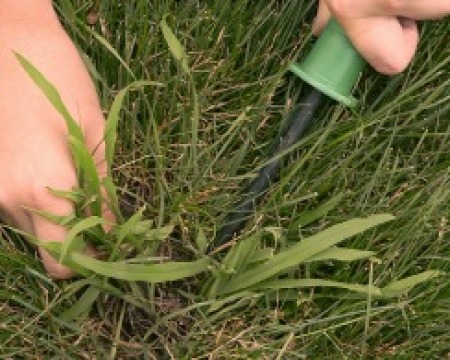
Crabgrass can be relentless. Because it grows fast and tends to thrive in hostile conditions, it can quickly turn your lawn into a tangled patch of weeds, if not kept under control. Here are a couple of organic solutions for fighting crabgrass that are easy, safe, and effective.

Different species of crabgrass are found throughout the United States and southern Canada. These annual weeds bloom on terminal spikes from July through September and can grow from 15 inches to 3 feet tall. Crabgrass stems grow upright or form a dense mat on the ground. The leaves are either hairy or smooth (depending on the species); a 1/4 inch wide, and have an elongated shape.
Next to turf grass, crabgrass looks light bluish green in color. Problems usually start along driveways and walkways, where heat and poor soil discourages turf grass from growing. Because crabgrass reproduces both by seed and from rooted-stems on top of the soil, it doesn't take long for crabgrass to quickly overwhelm your lawn.
The most effective way to treat crabgrass is to prevent it from germinating in the first place. A great organic "weed and feed" product that works as a pre-emergent herbicide on crabgrass is corn gluten meal (CGM). CGM is a natural by-product of commercial corn milling that contains corn protein. This protein acts like an herbicide by creating a chemical barrier at the soil's surface that prevents weeds from sprouting.
In addition to working on crabgrass seeds, research has shown that CGM is also effective at controlling the seeds of chickweed and dandelions. CGM is completely safe and poses no health risks to people or animals. In fact, because it is 60% protein, it is often used in livestock feed and pet foods. As an added bonus, CMG is also 10% nitrogen by weight, which is your lawn's favorite kind of fertilizer.
Where to buy it: CGM is available in both powdered and pelleted forms. Look for it at farm and feed stores, county co-ops, and places that sell garden supplies.
How and when to apply it: Timing is critical to the success of using CGM, because it doesn't work once seedlings emerge. Apply a first round in late April or early May (when surface soil temperatures reach about 55 degrees F), and a second application around mid-August. Spread the product evenly across your lawn at a rate of approximately 20 pounds per 1,000 square feet.
You can expect CGM to remain effective for 5 to 6 weeks each time you apply it. Although CGM will start working right away, don't expect to see immediate results. It takes about 4 years of annual applications to achieve complete results.
Pulling young plants out of the ground while in an early stage of development is a surprisingly effective means of control. Simply pull the plants up (stem, roots and all) before it has a chance to set seed.
What to look for: If you spot crabgrass seedlings with two or three leaves, or mature plants with a slender, green seed head that is still tightly closed against the leaves, go ahead and pull it up. If the seed head appears splayed open, however, leave it alone. Otherwise, you'll just scatter thousands of tiny crabgrass seeds all over the lawn. It's better to wait until spring and treat the affected area with a pre-emergent like CGM.
When to do it: Pull out crabgrass as soon as you spot it. Young plants leave only a small hole in your turf, which will quickly fill in with grass.
In reality, the most effective way to control crabgrass is to let your lawn do it for you. A thick, healthy lawn easily crowds out weeds, and creates a dense enough cover to prevent weed seeds from sprouting.
About The Author: Ellen Brown is an environmental writer and photographer and the owner of Sustainable Media, an environmental media company that specializes in helping businesses and organizations promote eco-friendly products and services.
Add your voice! Click below to comment. ThriftyFun is powered by your wisdom!
A well written article stressing the importance of two pre emergence treatments and when they should be given.
I don't agree with your suggestion of leaving 'splayed open seed heads' alone, though. If I happen across a dandelion ready to disperse it's seed at the slightest breeze, I ever so gently bend the head into a plastic grocery bag, then break the stem, catching all the seed in the bag.
I never permit crabgrass to reach a mature state with splayed open seed heads. If by oversight I did though, as with dandelion, I would try to catch all the seed in a bag rather than have hundreds more plants to deal with later on.
Add your voice! Click below to comment. ThriftyFun is powered by your wisdom!